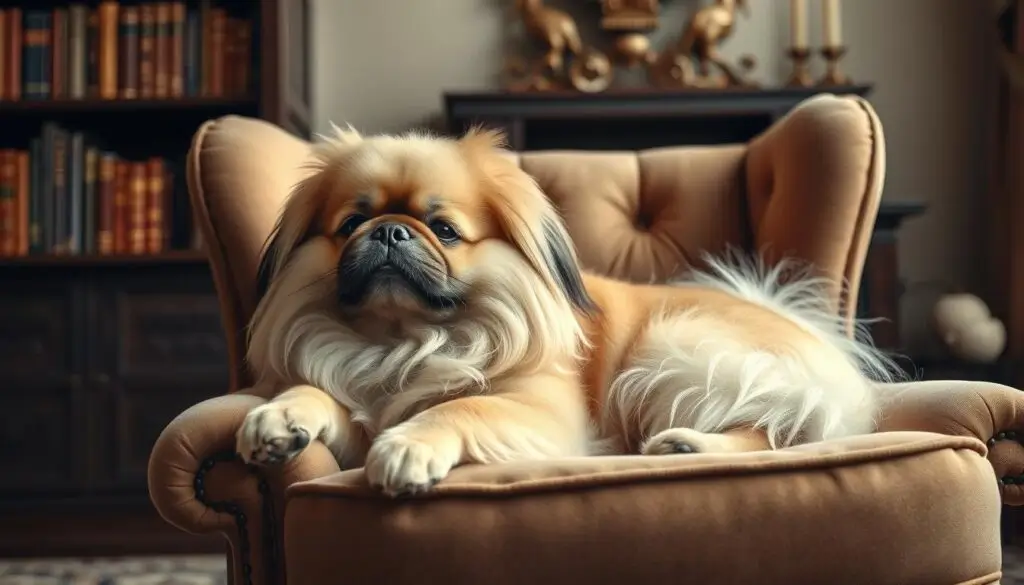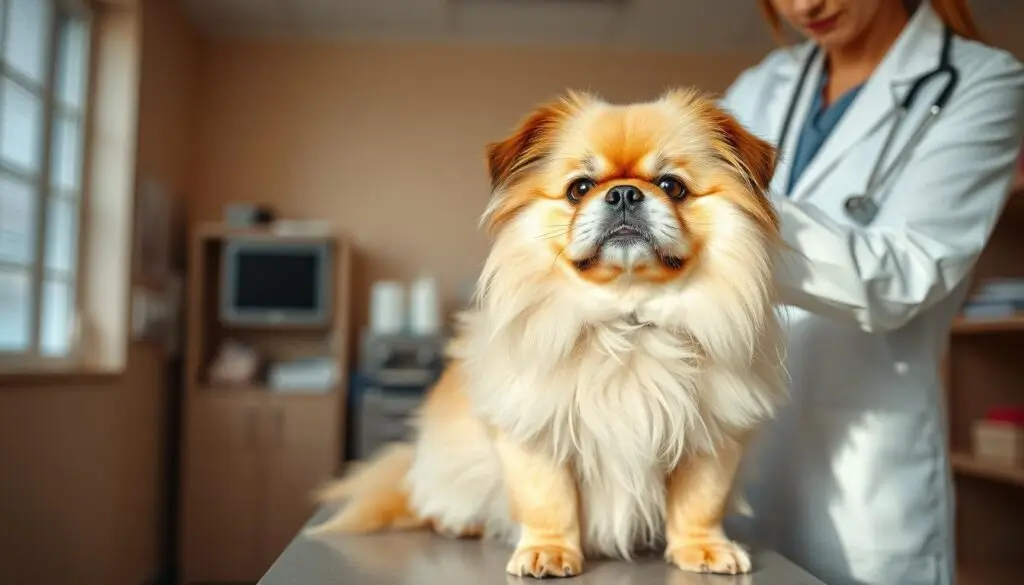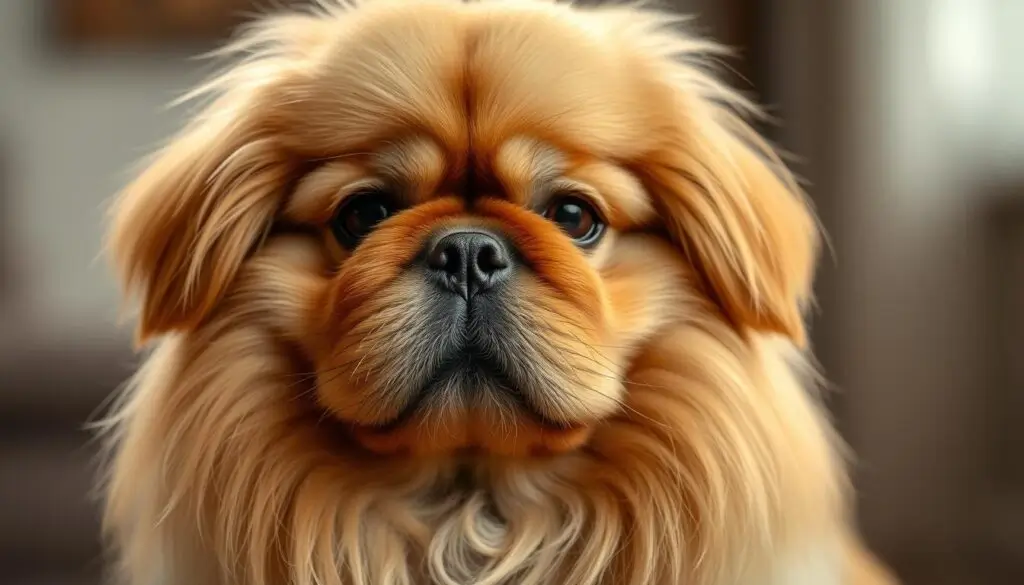Pekingese: Everything You Need to Know About This Loyal Companion
Imagine a tiny lion with a voice as bold as its history. For over 1,200 years, Pekingese dogs have been more than pets. They’ve been guardians, companions, and symbols of royalty. Their dignified rolling gait and lion-like mane still capture hearts today.
If you’ve ever been amazed by a Pekingese’s regal presence, you’re not alone. These small dogs have big personalities. They are loyal, vocal, and proud. But there’s more to them than their luxurious coats.
This guide explores the world of Pekingese. It covers their royal roots, daily needs, and why their small size hides a big legacy. Whether you’re thinking about adopting one or deepening your bond, this journey shows how their history shapes their traits today.
Table of Contents
Key Takeaways
- Originated as palace guardians in 8th-century China, symbolizing imperial status.
- Average 6-9 inches tall, weighing up to 14 pounds as a toy breed.
- Top performers at Westminster, winning hearts with their conformation since 1906 AKC recognition.
- Require weekly grooming and monitoring for health risks like brachycephalic syndrome.
- Live 10-15 years when cared for properly, thriving in calm, loving homes.
Introduction to the Pekingese Breed
For over 2,000 years, the Pekingese has won hearts as a royal symbol and a cherished pet. Their history is rich, with these dogs once favored by Chinese emperors. They were seen as the spirit of lions guarding palaces. Today, their history and unique pekingese characteristics still attract people worldwide.
Origin and Historical Significance
In China’s Tang Dynasty, Pekingese were sacred palace dogs, symbols of luck and protection. After the 1860 Opium War, they became sought-after pets in the West. One Pekingese even survived the Titanic and became famous.
The American Kennel Club recognized them in 1906. The Pekingese Club of America supported them since 1909. Their legacy lives on in dog shows and registries today.
Physical Characteristics Overview
- Stand 6–9 inches tall, weighing 7–14 pounds at maturity.
- Distinctive “lion-like” coat forms a flowing mane around their faces and bodies.
- Short muzzles and large eyes characterize their iconic facial structure.
Though small, their dense double coats and sturdy builds make them stand out. Their Toy Group classification shows their compact yet robust frames.
Global Popularity and Recognition
Ranked 49th by the AKC, Pekingese have a dedicated fanbase. Their dramatic coats and historical mystique make them stars at dog shows. Clubs like the Pekingese Club of America work to preserve their royal charm in today’s homes.
The Royal History of Pekingese Dogs
These dogs have a rich pekingese history, starting as symbols of Chinese royalty over 2,000 years ago. They were called “lion dogs” by Buddhist monks. They were bred to look like lions but smaller.
Only the Imperial family could own them. Owning one without permission was punishable by death. Their pekingese dog breed standards were strict, keeping their status as treasures.
- Exclusive imperial guardianship from the Han Dynasty onward
- Five survivors of the 1860 Summer Palace raid became Europe’s first specimens
- Queen Victoria’s prized dog Looty became a breeding cornerstone
- Post-1911 Revolution shift to global popularity
The 1860 Opium War made this pekingese history known worldwide. British troops found five Pekingese in Beijing’s ruins. These dogs were key to European breeding.
By the late 1800s, the pekingese dog breed was popular in England. They became symbols of status for the middle class. Their journey from palaces to show rings shows their long history of breeding.
Today, they still carry their noble heritage. Westminster winners like 2021’s Wasabi show their royal roots.
Physical Characteristics and Appearance
Pekingese dogs are easy to spot because of their special pekingese characteristics. These traits come from centuries of careful breeding. Their sturdy build and unique features make them look like royalty.
Size and Proportions
The pekingese is a small but solid breed. They grow to be 6–9 inches tall and can weigh up to 14 pounds. There are three sizes:
- Standard: 7–14 lbs (6–9″ tall)
- Mini: 7–9 lbs
- Sleeve: Under 7 lbs (named for fitting in royal sleeves)
Facial Features
Their flat face is a key feature. Important traits include:
- Black facial mask covering nose, chin, and mouth
- Round, dark eyes set wide apart
- Broad forehead and low-set ears with long feathering
- Distinctive “monkey-like” expression from wrinkled brow
Coat Variations
| Coat Type | Features |
|---|---|
| Undercoat | Soft, dense insulating layer |
| Outercoat | Long, straight guard hairs |
| Pattern Options | Solid colors (gold, sable) or bicolor combinations |
Lion’s Mane Coat
The “lion’s mane” around their neck and shoulders is a standout feature. This comes from their role as “lion dogs” in Chinese palaces. Their fur needs weekly brushing to avoid tangles.
Structural Traits
Breed standards highlight:
- Short, bowed front legs creating a “rolling gait”
- Curled tail resting over the hip
- Heavy bone structure despite small size
These pekingese characteristics give them a classic look when seen from the side.
Pekingese Temperament and Personality Traits

Pekingese dogs carry centuries of royal heritage in their small bodies. They have a temperament that mixes loyalty with a bit of royal distance. Their pekingese temperament shows love but also demands respect, just like their days in Chinese royal courts.
“One Pekingese named Sun Yat-Sen survived the Titanic disaster, one of only three dogs to do so.”
These small but strong friends love being close to their families. Here are some key traits:
Loyalty and Companionship
- They form deep bonds with 1-2 family members (40-50% bond strongly with a single person)
- They show protective instincts, even though they are small
- They were bred as companions to Chinese royalty, valuing family over strangers
Independence and Stubbornness
Training them needs patience because of their confident nature:
| Training Challenges | Success Factors |
|---|---|
| 50-60% success rate without professional guidance | Positive reinforcement boosts outcomes by 60-70% |
| Less playful than Labs (1:3 playfulness ratio) | Short, frequent training sessions recommended |
Behavior Around Others
They are loving with people they know, but different with strangers:
- 70-80% likelihood to bark at unfamiliar visitors
- 30-40% chance of nipping if provoked
- Require gradual introductions to children older than 6 years
Pekingese do best in calm places where their pekingese pride is honored. Their history as gifts to dignitaries shows they expect to be treated with respect today.
Essential Grooming Tips for Your Pekingese
Proper pekingese care guide starts with daily brushing to manage their long double coat. Use a slicker brush and metal comb to remove tangles. Focus on high-risk areas like behind ears and under tails. Weekly sessions should last at least an hour to prevent painful mats.
- Bath every 3-4 weeks with dog-specific shampoo—never human products—to maintain skin pH balance.
- Clean facial folds daily with a damp cloth to avoid infection risks. Check eyes and ears weekly for redness or discharge.
- Trim nails every 2-3 weeks, avoiding the quick. Professional groomers can help with precision cuts.
- Incorporate dental care into routines: brush teeth 3-4 times weekly to prevent plaque buildup in small jaws.
During shedding seasons, increase brushing to twice daily. Avoid cutting the “lion’s mane” coat too short to preserve temperature regulation. Always inspect for skin issues during sessions, as grooming doubles as health checks. Professional grooming every 6-8 weeks ensures optimal coat condition.
Use hypoallergenic products and prioritize gentle drying after baths to prevent respiratory discomfort. Consistent pekingese grooming tips protect against matting, infections, and joint strain from heavy coats.
Health Concerns and Common Medical Issues
Pekingese health issues often come from their brachycephalic traits and body shape. It’s crucial to follow a pekingese care guide to ensure they live a long life. Regular vet visits and proactive steps can help prevent problems.

Respiratory Challenges
Many Pekingese face brachycephalic syndrome. Look out for signs like hard breathing or snorting. These need vet attention right away. Keep them cool and under 14 pounds to ease breathing.
The AKC suggests avoiding hard exercise when it’s hot.
Eye and Joint Care
- Eye conditions: Check eyes weekly for discharge. Use vet-recommended drops for dry eye.
- Joint health: Provide orthopedic beds and limit stairs. Watch for limping, a sign of patellar luxation.
Screenings and Lifespan
Annual screenings for heart, eyes, and joints can help them live 12-14 years. The AKC suggests heart exams start at age 6. Dental cleanings every 12 months help prevent infections.
Key Health Management Table
| Health Issue | Symptoms | Care Tips |
|---|---|---|
| Brachycephalic Syndrome | Labored breathing, noisy panting | Avoid heat, maintain ideal weight |
| Corneal Ulcers | Eye redness, squinting | Clean eyes daily with vet-approved solutions |
| Patellar Luxation | Lameness, limping | Use joint supplements like glucosamine |
| Heart Conditions | Lethargy, coughing | Yearly echocardiograms |
A balanced diet with omega-3s is good for joints and heart. Stick to the pekingese care guide for their special needs. Regular vet visits help keep your Pekingese healthy and active.
Training Your Pekingese: Challenges and Solutions
Pekingese training needs special approaches because of their independent nature. They do well with positive reinforcement and short, fun sessions. Their royal background makes them respond best to respectful and consistent training.
Potty Training Techniques
- Use a crate sized to allow the dog to lie down and turn comfortably (ideal for 14-pound adults).
- Limit crate time to 3–4 hours daily to avoid anxiety.
- Pair crate entry with treats and calm praise to build positive associations.
Socialization Strategies
Early exposure to different things is key. Pekingese puppies need slow introductions to people, sounds, and places. Their alertness makes them great watchdogs, but they can be wary. This can be managed with:
- Short, controlled meet-and-greets with visitors.
- Desensitization exercises to reduce overreactivity to noises.
Managing Stubborn Behavior
Stubbornness comes from their strong will. Effective training uses:
- High-value rewards like liver treats for quick response.
- Breaking commands into small steps with frequent praise.
| Training Method | Why It Works |
|---|---|
| Positive Reinforcement | Aligns with their desire for respect. |
| Consistency | Reduces confusion and resistance. |
Owners who use the pekingese training guide “Pekingese 101” see great results. This guide, priced at $26.95 (82% off), originally $154.39, includes 130 treat recipes and lifetime consultations. There’s also a 60-day refund policy for satisfaction.
Dietary Needs and Nutrition Guidelines
A good pekingese care guide begins with the right food. Pekingese dogs do best on high-quality dog food with real meat first. Look for kibble with at least 38% protein to meet their energy needs.
Feed them 2-3 times a day to avoid overeating. This also helps with their breathing.
- Puppy diets: Need triple daily feedings with nutrient-rich formulas.
- Adult portions: 0.5–0.75 cups split into two meals to avoid obesity risks.
- Senior diets: Include glucosamine-rich foods like ProDog Flexx to support joints.
Choose brands like ProDog Muscle+ for tri-protein blends or ProDog Shine for coat health. Stay away from table scraps with onions, chocolate, or xylitol—they can be deadly. Always talk to a vet before changing foods, and do it slowly over 7–10 days.
Supplements like ProDog Protect can help with allergies, and ProDog Digest’s marshmallow root aids digestion. Keep treats under 10% of their daily calories. Regular vet visits are key to keeping your pekingese healthy and on track with their nutritional needs.
Exercise Requirements for the Pekingese
Pekingese dogs need special exercise plans because of their brachycephalic features and small size. The pekingese care guide suggests low-intensity activities to keep them healthy. Their short snouts and small size mean they should avoid strenuous exercise.
Indoor Activities
- Short 10-minute play sessions with puzzle toys or fetch
- Mild training sessions focusing on obedience or tricks
- Interactive feeding puzzles to stimulate mentally
Safe Outdoor Exercise
When going outside, use a harness instead of a collar to avoid tracheal stress. Daily walks should be 2030 minutes, split into two sessions. The pekingese dog breed likes leisurely walks and should avoid steep inclines. Always carry a portable water source.
Weather Considerations
| Weather Condition | Activity Recommendations | Risk Mitigation |
|---|---|---|
| Hot Weather | Early morning/late evening walks | Avoid midday heat; monitor for labored breathing |
| Cold Weather | Short outings with dog sweaters | Limit exposure to freezing temperatures |
Regular exercise helps prevent obesity and behavioral problems. Signs of too much exercise include excessive panting or feeling tired. Always adjust routines based on individual needs using this pekingese care guide. Their high intelligence means they need both physical and mental stimulation.
Is a Pekingese Right for Your Lifestyle?
Choosing a Pekingese means knowing its special traits. These small dogs weigh 6–14 pounds and love quiet, stable places. They need careful handling because of their short snouts and breathing issues.
- Space: They fit well in apartments but need cool, well-ventilated areas.
- Exercise: They need short walks, 15–30 minutes, and should avoid hot weather.
- Behavior: They like calm places and might not do well in loud homes with kids.
Weekly care includes:
- Brushing 3–4x weekly to manage their dense coat
- Monthly bathing with dog-specific shampoo
- Daily interaction to satisfy their social needs
ExpenseCost RangeAdoption/Purchase$800–$2,000Annual Vet Care$600–$1,000Grooming$30–$60/monthFood & Supplies$50–$100/month
Prospective owners should know they live 12–14 years. Their loyalty and love make them perfect for those who can give them constant care and attention. Pekingese dogs are dignified and great companions, not active playmates.
Conclusion: The Enduring Charm of the Pekingese Companion
The Pekingese has a rich history, dating back over 2,000 years. They were once sacred companions to Chinese emperors. Today, they are known for their loyalty and self-assuredness.
These small dogs, weighing 6–12 pounds, need a lot of care. They require daily grooming of their long coats and monitoring for health issues. Their lifespan of 12–15 years means they can be a companion for many years.
Ranked 92nd by the AKC, the Pekingese remains popular. Their lion-like manes and bold personalities attract many. However, they shed a lot, need special care for their breathing, and can be assertive.
If you’re ready to meet their needs, a Pekingese can offer a lifelong bond. They are a mix of ancient tradition and modern pet ownership. Finding a reputable breeder or rescue is crucial to give them a loving home.

